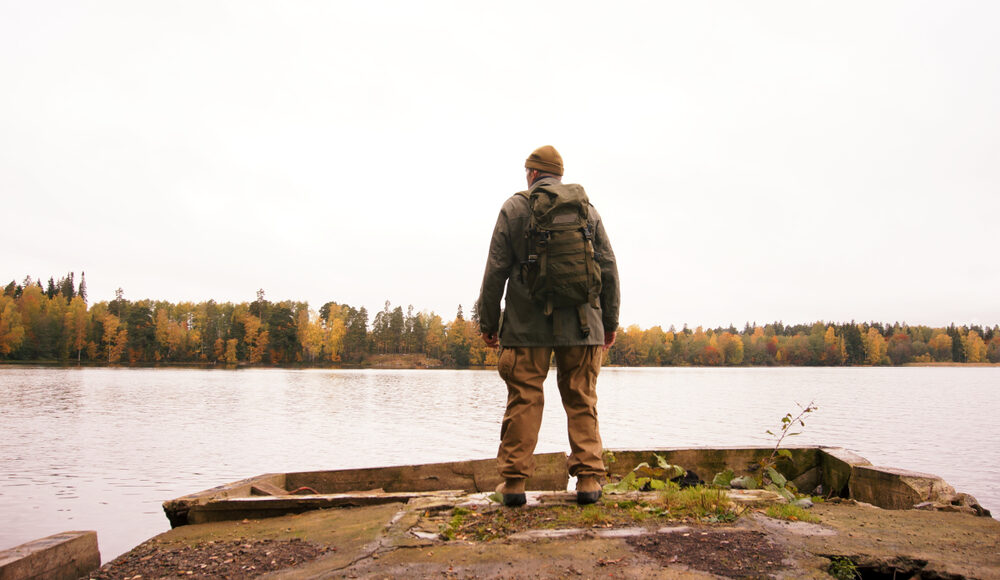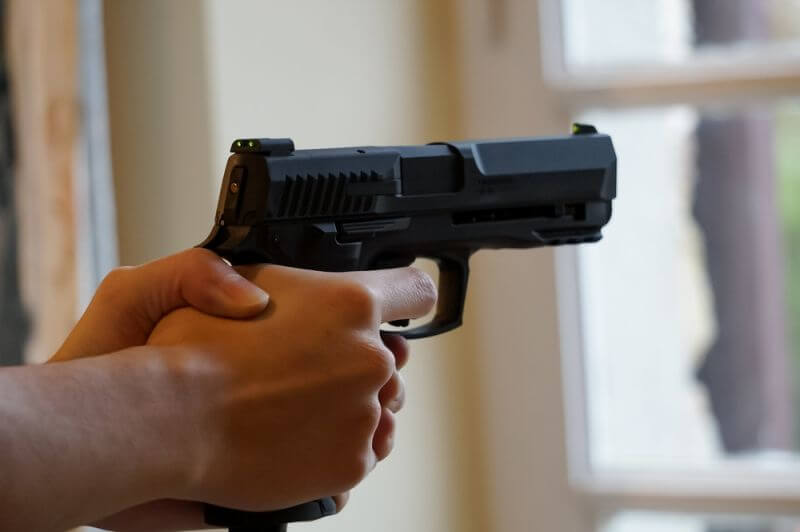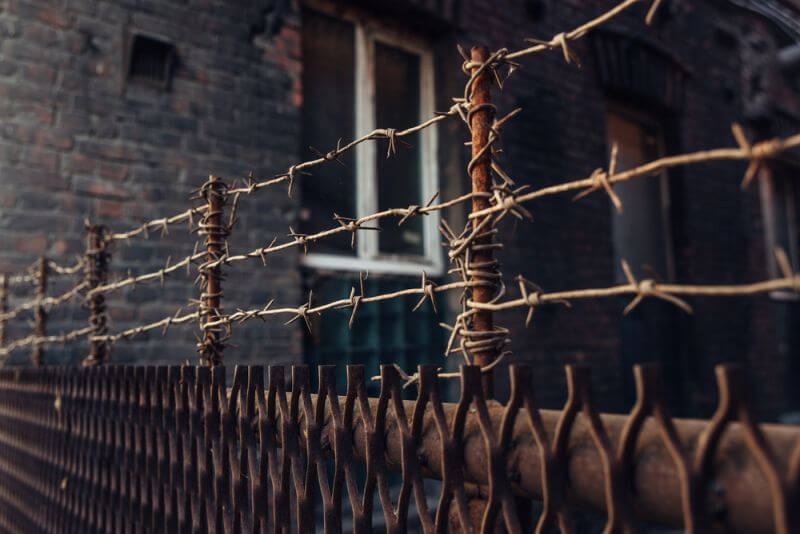I had an interesting dream the other night; a genuine prepper dream. In it, I had been out of town speaking and was on my way home. While at the airport, mushroom clouds started appearing on the horizon, indicating that we were on the receiving end of a nuclear attack. All flights were canceled, and I suddenly had to find a way to get home. Even worse than that, one of my married daughters was there with me, and I had to get her back to her home, which is about 150 miles from my own.
Granted, it was just a dream; but it’s as realistic a scenario as any, especially considering how crazy Putin has been acting. The interesting thing to me was that although I have gamed out a variety of get-home scenarios in my mind, this was different in that I was a few hundred miles away from home. That’s a whole lot worse than just being at work, ten miles or so away.
So, what do we do in such a situation?
To start with, we should be prepared for something like this to happen. After all, we’re preppers, and that means we’re the ones who are prepared when the brown stuff meets the rotary air movement device. I think that scenario I dreamed about fits that description.
The Get Home Bag
We’ve all heard about a get home bag (GHB), so I’m not going to belabor the point, but it needs to be mentioned. My get home bag and everyday carry bag (EDC) are one and the same and normally reside in the trunk of my vehicle. Actually, I have two of them, one for each vehicle; and they’re equipped basically the same. My GHBs are essentially supersized survival kits, designed to give me what I need to have in order to walk home 100 miles, should I have to.
Whenever I travel, I take my GHB with me unless I’m carrying a full backpack that I have as an emergency kit. It is essentially a bug out bag, but I use it for more than that. If I’m driving wherever I’m going, I’ve already got my GHB with me; but it goes in my suitcase if I’m not driving. When traveling by air, it is accompanied by a gun case as well. That makes my suitcase a bit big, but I’ve got what I need.
Just to clarify, I don’t recommend using a bug out bag (BOB) as a get home bag. While it will function in that way, it might mean that you’ll use up some of the contents of your BOB, especially food, before you can bug out. If you’ve got to bug out immediately after arriving, that can be a problem.
So, just what do I have in my get home bag?
To start with, the bag itself is a Condor EDC cross-body bag. I like this particular bag because it has a lot of pockets and compartments, making it easy to organize my stuff. I’m big on organization; because it makes it easier to find things when I need them. The bag also has MOLLE straps on it, allowing me to attach things on the outside. Although I don’t actually use those straps for additional MOLLE pouches, they’re great for flashlights, multi-tools, and knives.
Shelter
- 2 Rescue blankets
- Ten yd Duct tape
- 30 ft Paracord
- Rain Poncho (can be used as a tent)
- Heavy-duty hair bands (better than rubber bands for holding things together)
Food & Water
- Lifestraw water filter
- Collapsible water bottle
- 4 Spare ziplock bags (good for storing food or as extra water bottles)
- Hose bib key (for opening commercial faucets)
- Esbit stove with extra fuel (works to heat food, even when there isn’t any wood available)
- Spork
- Collapsible cup
- P-38 can opener
- Snacks (jerky, granola bars, nuts)
- 2 – 12” x 24” heavy-duty aluminum foil for cooking with
- Survival fishing kit (line, bobbers, weights, and hooks)
First-Aid & Personal Hygiene
- Cloth adhesive bandage strips and knuckle bandages
- Abdominal bandages
- Cohesive medical tape
- Stretchy gauze
- Neosporin (antiseptic cream)
- Insect repellant
- Alcohol wipes
- Steri-strips
- Tylenol and ibuprofen
- Antihistamines
- Five day supply of my personal prescription medications
- Personal hygiene kit (soap, toothpaste, Kleenex, toothbrush, compressed towels, TP)
Fire Starting
- Windproof lighter
- Stormproof matches
- Metal match
- Petroleum jelly & cotton balls
Tools
- Flashlight with extra batteries
- Small sheathe knife
- Knife sharpener
- Multi-tool
- Wire saw
- Compass
- Lock pick set
- Pad of waterproof paper with pen and pencil
Miscellaneous
- Phone charging battery
- Solar phone charger
- Car & house USB chargers
- Cable for charging my phone
- Batteries for my EDC pocket flashlight
- Paper clips & binder clips
- Safety pins
- Copies of my driver’s license and passport
- Emergency contact phone list
- Fresnel lens (magnifying glass; can be used to start fires too)
As you can see, not everything on that list would typically be found in a survival kit. This is also my EDC bag, so it has things that I might need on an everyday basis. But those things might just be useful to help me get home in a pinch. I almost always have a jacket and some sort of hat with me.
One last thing I need to mention is that I always travel with cash, as well as with a debit card to an account that has enough money for me to get home. When I was traveling extensively in Mexico, I had a travel account I would use, maintaining it separate from my regular account. That way, if someone stole my card, they would only have access to a limited amount of money; but I would have access to it if I needed it.
First Actions
Ok, so now that we’ve got that out of the way, what should our first actions be if we’re stuck far from home and have to get home. I’m going to assume that we don’t have a vehicle with us, like in my dream. That just makes things harder, as having a vehicle means we can just start driving.
Things will undoubtedly be in disorder as people come to grips with the situation. Some will be screaming for answers, expecting someone else to solve their problems. Others will be sitting or standing around, trying to get grips with what’s happening and hoping they’ll wake up. Few will be taking any useful action, but you need to be one of those. There will be a short window of opportunity before all those people figure out what they have to do. Take advantage of it.
Going back to the scenario in my dream, my first stop would be at the rental car counter to get the smallest car with the biggest cargo capacity I could find, preferably a small SUV. I want small for good gas mileage, but at the same time, I want cargo capacity because I’m going to be picking up whatever supplies I can along the way.
Once I have a car, the next step is to try and get my luggage back if I don’t have it in my possession. Remember that I have my EDC bag and a pistol case in there, with a couple of extra loaded magazines. About the only time that leaves my control is to go into the belly of an airplane, but that’s the assumption I’m using right now. Any other time this wouldn’t be an issue, as I would already have it.
From there, I’d find the nearest Wal-Mart, Target, Sam’s, or other large store where I could stock up on food, water, some gas cans and maybe a sleeping bag or blanket. The idea is to get the most I can in one stop so that I can get out of town. Trying to buy a tent would probably be too much, but that’s not a problem, as I’d sleep in the car. If I see a large backpack, I’ll grab that too, just in case. The idea is to make sure that I have more than enough to get me home, as I don’t expect to be able to get anything along the way. If I couldn’t get my suitcase, I’d pick up a few changes of clothes, just whatever I could find that would fit.
If I couldn’t get my hands on my suitcase, then I would be without a gun, so my next stop would be to find a gun store. I have a concealed carry license, so that should speed me through the approval process for buying a gun in most states. I’d take what I could get, but would prefer a 9mm semi-automatic of some sort.
One more stop before heading out of town; that’s the gas station to top off the vehicle’s tank and fill my gas cans. This is another “the more, the better” situation, as there’s no telling whether gas will be available along the way. Ideally, I’d try to get enough gas to get me home, just in case.
Whew! All that was done at breakneck speed; time to catch my breath.
READ MORE: World War III on the Home Front
ET Phone Home
Sometime during all that rushing around, I’d try to call my wife so that I could share my assessment of what is going on, and what’s likely to happen in the next few days, and let her in on my plans to get home. We have enough at home so that she would be fine, but she’d be concerned about me. There’s also the risk that the phones would go down, so I’d want to make sure I called her as quickly as possible, even if it was for a short call.
Hopefully, that wouldn’t be the only call. Once I got on the road, I’d be calling again, probably every few hours. There would be two purposes to those calls. The first is to reassure her that I was on my way and that I hadn’t died in a fiery accident somewhere. And the second would be to help direct her actions so that she could take advantage of the time to make last-minute preparations. In order to do that, I’d tell her to call in sick or otherwise take time off.
There are a few specific items that I’d want her to try and do during that time:
- Buy whatever extra food she could to top off our stockpile
- Buy personal hygiene supplies, especially TP
- Fill up water containers
- Buy gas cans and fill them. In my dream, I told her to fill the tank every time she left home, which sounds like a good idea to me. We live 20 miles from the nearest Wal-Mart, so each time she went, she’d burn through a couple of gallons of gas.
- Buy seed, potting soil, and fertilizer so we could expand our garden
Making the Drive Home
There’s no telling what driving home is going to be like or whether I’ll be able to drive all the way home. Regardless, I’ll try to drive as far as possible, with the understanding that I’m not married to that car. If I have to abandon it and take off on foot, then that’s just what I’ll do. That’s why I said I’d buy a backpack if I found one.
It would probably be best to avoid the major highways, as there will probably be a lot of other traffic out there. Where they will be going is beyond me. I imagine some will be trying to make it home, just like me, but I think there will be others who will just be trying to escape, not having any idea where they are going.
Ideally, it would be best to be on the roads when others are not and to hide out and sleep when the roads are crowded. That might mean that it is best to drive at night, but it would be necessary to evaluate that at the time and make the best guess at what will work. At the same time, it would be best to keep driving as many hours per day as possible while still getting enough rest to avoid falling asleep. After all, the idea is to get home, not spend a lot of time on the road.
Finally, I’d use the travel time to continue picking up whatever supplies I could, as long as I could do it without slowing down my travel. One place I would be sure to stop is gas stations, filling up the car’s tank whenever I could. My normal travel rule of thumb is to fill up when I reach half a tank. I’d probably continue along that line, trying to avoid using the gas I had in the gas cans for as long as possible.
I’d also stop somewhere to buy some good walking shoes, just in case I had to abandon the vehicle and head out on foot. While I was at it, I’d try to get some basic backpacking gear if I could.
Abandoning the Vehicle
It may be necessary to abandon the vehicle along the way, either due to a mechanical breakdown, running out of gas, the roads becoming impassable, or the vehicle attracting too much attention by being one of the few vehicles on the road. I don’t want to get in a fight, so if it looks like driving is going to lead me into a fight, I’d rather abandon the vehicle and head out across country. Since it’s a rental vehicle, it’s no skin off my nose to abandon it.
Walking home would be challenging but possible. It would be best to stay off the roads and out of sight as much as possible. There are plenty of places to walk, which offer at least some concealment. The bigger challenge is making sure that I don’t get lost and waste time trying to find my way home.
The average person can walk about 20 miles per day. That’s a tough day, and it will tire just about anyone out, but it can be done. That’s 100 miles in 5 days. But to do that, it’s necessary to find enough food and water and get enough rest.











Illini Warrior | April 19, 2022
|
Good mind exercise to practice while killing time is to thoroughly explore stores that you normally wouldn’t think “SHTF and GHB/BOB” – when you get caught away from home and need to improvise a GHB and lasting supplies to get home – might not have a Wally World, Home Depot or a Cabelas – it might be Hobby Lobby, Bed Bath & Beyond and a $1 Store >>> What’s available for hauling some fuel safely? – How can I fabricate a weapon? – Is there an ersatz knapsack in there somewhere?
Leam | April 19, 2022
|
Of course there’s always the possibility that the “disaster” might consist of one’s vehicle being on fire and a large number of “nasties” between oneself and a store. Leaving one with only the skills they possess and what’s in one’s pockets for the long walk home. A get home bag and vehicle is nice, but I wouldn’t rely on it as a given.
Desert Fox | May 27, 2022
|
I’m reading a novel by A. American “Going Home” that addeses just that topic after an EMP occurs and he is 150 miles away from home. Thank you for your article and suggestions. I don’t travel much but who knows when Murphy will appear. It’s good to be prepared!
Rodewar | February 28, 2023
|
That’s a great series!
Nedra Fraley | February 28, 2023
|
If you could see mushroom clouds, the likelihood that you could find a car to start, let alone anyone willing to stop and go through the hassle of renting you one without being able to use their computers is slim to none. Again, most stores and gas stations will not bother to continue business after their lights go out. You’d be on foot and probably only able to access what you can scavenge or barter on the way. And getting your bag back? Computers, again. Unless you are able to get out and pull it yourself. Security is likely to be the only ones still working because life works like that. You need to recalculate. What you’ve presented is an unlikely best-case scenario.
Shya | March 3, 2023
|
Nedra Fraley, you nailed a pertinent point. If the first few sentences make mention of the mushroom cloud, then yes, the included EMP that follows many of these, depending on the OP’s distance from it, eliminates the likelihood of using credit cards to rent or purchase almost all of the items many places have. Here, again, as is often considered in such cases, cash is King, at least initially.
Additionally, yep, getting HIS suitcase out of the plane, if not in the overhead bins, is going to be a challenge, further reducing his supplies.
What we have ON US is going to matter most, combined with whatever is in our heads. That’s our biggest potential asset, our knowledge base..
I love the fact that women participate and are interested in being as ready as they can. As a man from a more chivalrous age, yet a supporter of equality, I embrace and salute you.
Alan | April 6, 2023
|
I think the best thing to do in that situation is to make the best of what you have at the time and always have some basic things in your pocket at all times; cash, flashlight, snacks, debit or credit card, meds, pocket first aid, water bottle, lighter, solar charger, phone.
Having the survival skills for the situation and location you’re in is vital. Knowing how to make things or gather things for survival is key, no matter where you’re. Trying to get home may not be feasible until you stabilize your ability to do so. It may mean re-stabilizing in each location along the way.